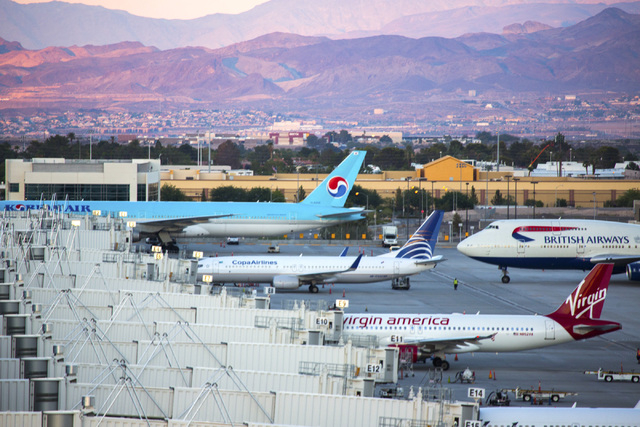At McCarran, the name of the game is international
Southern Nevada tourism officials haven’t lost sight of keeping the “international” in McCarran International Airport.
Ever since the airport’s $2.4 billion Terminal 3 opened its gates to the world in June 2012, McCarran has been among the fastest-growing international gateways in the United States.
A team of air service development professionals from McCarran and the Las Vegas Convention and Visitors Authority has collaborated to recruit more flights and more passengers to Las Vegas.
It’s a financially lucrative strategy: Based on years of research, the tourism industry knows that because international visitors travel a long way to get here, they’re more likely to stay longer and spend more than their domestic counterparts.
A GOAL OF 30 PERCENT
The international market is the place to be, and the Las Vegas Convention and Visitors Authority has set a goal of building the percentage of international travelers from 20 percent of the total to 30 percent by 2020.
Since Southern Nevada is poised to break all visitation records with more than 40 million arrivals in 2014, the authority is looking to increase the foreign totals from more than 8 million to more than 12 million people a year.
Air service developers believe the way to do that is to recruit foreign air carriers to get nonstop routes from abroad into McCarran.
It isn’t an easy task. Many of the aviation heavyweights don’t want to risk dedicating an aircraft to anything other than a hub-to-hub operation.
McCarran has a few of the heavyweights — British Airways, Virgin Atlantic, Korean Air, Air Canada and Aeromexico among them.
But most of the recent growth has been in the recruitment of lesser-known carriers. Usually, it’s easier to make a case to a small foreign carrier to fly over traditional hub airports such as Los Angeles, San Francisco, even Salt Lake City.
INTERNATIONAL RECRUITMENT
Local recruiters make the case that most passengers prefer the direct nonstop flight over arriving at a hub and changing planes to get to Las Vegas, and some airlines have bought into that.
Edelweiss Air, a subsidiary of Swiss Air that is part of the Lufthansa group, will add a third weekly flight from Zurich to Las Vegas next year.
Volaris, a Mexican discount carrier that once had a partnership with Southwest Airlines, is sold on Las Vegas and later this year will add a new nonstop between Cancun and Las Vegas.
Recruiters point to the wildly successful run Panama City-based Copa Airlines has had with Las Vegas. Copa officially was the first international carrier to fly into Terminal 3.
Copa offers 12 flights a week to and from Panama City, up from seven a year ago. McCarran officials are optimistic the airline will increase that to two flights a day.
Using Panama City as a connecting point, Las Vegas has a one-stop reach to nearly every major city in Central and South America with Copa.
WELL-TIMED SUCCESS
Success on the international front couldn’t have come at a better time for Las Vegas.
The domestic aviation industry is slimming down through mergers and acquisitions. Delta Air Lines swallowed Northwest Airlines. United absorbed Continental. America West’s management team took over US Airways, which in turn became American Airlines. Southwest gobbled up AirTran.
At the same time, the U.S. domestic market suddenly learned how to be profitable through capacity controls.
Instead of sticking planes and flights on routes that often ran empty in all corners of the country, they applied research and history to determine the best places to fly at near capacity.
Airlines bought more fuel-efficient planes and added more seats to them, running fewer flights. The end result was planes filled to capacity, grumpier passengers, more lost bags and customer service complaints — and bigger profits.
In Las Vegas, the domestic capacity tumbled and only recently has seen some rebounds. Southwest continues to recognize Las Vegas as a valuable commodity, Spirit Airlines and Allegiant Air embraced the city with their low-cost, high-fee business models, and airlines such as JetBlue and Virgin America found profitable niches.
MODERATE GROWTH
The new challenge for Las Vegas is to sustain the moderate growth and keep tabs on capacity concerns. It’s a high-wire tightrope walk that Clark County Aviation Director Rosemary Vassiliadis has learned from her predecessor, Randall Walker.
When Las Vegas crossed into the new millennium 14 years ago, McCarran passenger counts were hovering just north of 30 million passengers a year.
From 2003 to 2005, growth shot up by high single-digit percentages. There were record passenger counts every year from 2002 to 2007, the year McCarran maxed out with its all-time high of 47.7 million passengers.
Walker was beginning to sweat a capacity crunch, proclaiming that 53 million passengers would be as much as McCarran could handle without expanding.
IVANPAH AIRPORT
That’s when Clark County began exploring a reliever airport in the Ivanpah Valley south of Las Vegas, near Primm. At the time, there were dreams of high-speed rail or a maglev line down Interstate 15 to Southern California and planners figured an Ivanpah Valley airport could be linked to McCarran by rail.
Then, the economy tanked.
In 2008, passenger traffic dropped off to 44.1 million. It spiraled to 39.8 million in 2010, and county commissioners boldly decided to press on with Terminal 3 despite the dismal numbers.
It turned out to be the right move.
From 2011 to 2013, between the lackluster domestic numbers and the hot international counts, McCarran increased at a sustainable low single-digit percentage with counts of 41.5 million in 2011, 41.7 million in 2012 and 41.9 million in 2013.
This year, traffic for the first three quarters is up 2.4 percent over 2013, meaning it likely will clear the 42 million mark.
Terminal 3 gives Vassiliadis expansion options Walker didn’t have.
With all the international arrivals out of shuttered Terminal 2, McCarran won’t have the same constraints it once had.
“We gained some potential airside space when Terminal 2 closed,” Vassiliadis said in a recent Las Vegas Review-Journal editorial board meeting to discuss the United States’ Brand USA initiative to increase foreign travel to America.
NEW CAPACITY: 55 MILLION
“With Terminal 3 open, our capacity is now at about 55 million passengers,” she said.
How Terminal 3 was designed adds to its flexibility. The terminal’s 14 gates can accommodate domestic or international arrivals. At present, all international traffic arrives at that facility, and passengers are easily routed to U.S. Customs and Border Protection. International arrivals come in on the terminal’s east end; some domestic flights gate on the west side. Gates along the center of the building have flexible corridors to accommodate either.
As more international routes are scheduled, airport officials can plan accordingly. Although there are plenty of gates and scheduling blocks available, the challenge has shifted to accommodating airlines when they want to arrive, having gate facilities that are available for large aircraft and having enough Border Protection agents available when several flights come in at around the same time.
Vassiliadis said having enough federal agents once was a problem, but the state’s congressional delegation worked with the Homeland Security Department to make sure there was enough personnel to handle McCarran’s growing international traffic.
For now, it appears that building a new airport in the Ivanpah Valley is on the back burner.
TOUGH SPLIT
“Splitting operations is really tough for the airlines,” Vassiliadis said. “There’s no easy way to do that for airlines that have both domestic and international routes.”
There aren’t any airlines that fit in that category today, but Southwest and Allegiant have talked about adding international routes. Several of the large legacy carriers have relationships through code-sharing agreements and airline alliances that could complicate schedules.
As far as gate expansion, McCarran has the option of using the space where Terminal 2 once operated.
“The Terminal 2 space gives us some flexibility for operations,” she said.
There aren’t any definitive plans for adding gates in that space, but Vassiliadis acknowledged that it would be fairly easy to connect the old Terminal 2 space with Terminal 1.
“We have plenty of space in north ticketing, so it would be pretty easy to put a very small concourse out there if we needed it,” she said.
Another option is connecting more capacity from Terminal 3 to the northern wings of the D gates.
For now, all of that is on hold until there’s a clearer picture on how the airline industry will shake out.
What is clear is that international is the name of the game for McCarran.
NEW STATE STRATEGY?
State officials have taken note of the efforts of McCarran and the Las Vegas Convention and Visitors Authority to add routes. At last month’s Governor’s Conference on Tourism, airline route developers from McCarran, Reno-Tahoe International Airport and Elko Regional Airport discussed strategies to attract more air service to the state. Lt. Gov. Brian Krolicki, who heads the Nevada Tourism Commission for 1½ more months, would like to see the state’s airports work together on air service development, a strategy that isn’t likely to be embraced by Las Vegas because the city’s needs are so much different from Reno’s and Elko’s.
Reno is still trying to recover from service reductions by its domestic carriers while celebrating its first two international flights, a twice-weekly route from Guadalajara, Mexico, on Volaris, beginning in December and three seasonal flights a week from London’s Gatwick International Airport on Thomas Cook Airlines starting in December 2015.
Contact reporter Richard N. Velotta at rvelotta@reviewjournal.com or 702-477-3893. Find him on Twitter: @RickVelotta



















